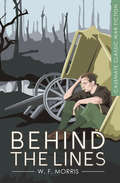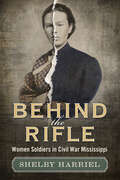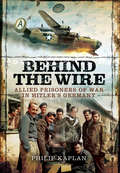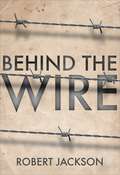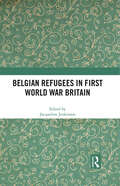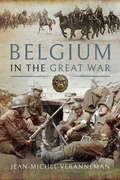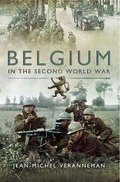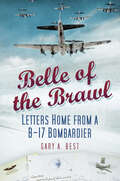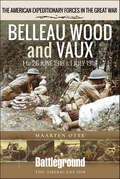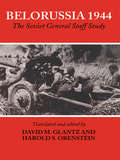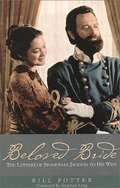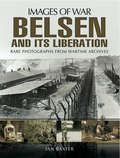- Table View
- List View
Behind the Lines: A Novel (Casemate Classic War Fiction #6)
by W. F. MorrisAfter killing a fellow officer, a British World War I fighter joins the ranks of deserters and outlaws in a suspenseful novel from the author of Bretherton.Behind the Lines follows army man Peter Rawley, who accidentally kills an overbearing, taunting fellow officer and, terrified that he will not receive a fair hearing amid the chaos of the trenches, flees the battlefield. Now a fugitive, Rawley must join forces with other deserters, criminals, and lost soldiers in a hand-to-mouth existence, trying to survive in the no-man&’s-land between opposing armies. He will encounter both adventure and disaster, including capture by the Germans and the threat of a firing squad—and will need to call upon his own bravery and the support of the woman he loves to survive. A thriller from the author of Bretherton: Khaki or Field-Grey?—which was praised by the Sunday Times as &“a mystery as exciting as a good detective story and an extraordinarily vivid account of trench-warfare&”—this is a meditation on the issues of identity and allegiance, as well as the role of chance. Behind the Lines is a classic of WWI fiction and an exciting read that brings the drama of the Great War to life.
Behind the Lines: The Oral History of Special Operations in World War II
by Russell MillerThis is the story of special operations in the second world war as it has never been told before--directly by those who took part.Compiled by Russell Miller from interviews, diaries, letters and contemporaneous first-person accounts--many unpublished until now--the oral history in Behind the Lines follows the adventures of the courageous men and women who volunteered for service with the Untied States' Office of Strategic Services and Britain's Special Operations Executive. They parachuted behind enemy lines, often alone, with orders to cause mayhem. Arrest almost always resulted in torture and imprisonment; sometimes in execution.Trained in the black arts of warfare--sabotage, subversion, espionage, guerrilla tactics and undermining enemy morale by the distribution of insidious propaganda--theirs was a war fought in the shadows. Their activities extended to every theatre of operations: in occupied France, equipped with false identities, they played a deadly game of cat and mouse with the Gestapo; in the Balkans they discovered that the fiery politics of the region were as dangerous as the enemy; in the Burmese jungle, in some of the worst combat conditions of the war, they led native marauders in surprise attacks against the Japanese. From Britain they were supported by a team of back-room inventors who produced expertly forged documents and dreamed up ingenious devices like exploding rats and invisible ink. The special agents of World War Two really were a breed apart. This is their extraordinary story. In their own words.
Behind the Rifle: Women Soldiers in Civil War Mississippi
by Shelby Harriel-HidlebaughDuring the Civil War, Mississippi’s strategic location bordering the Mississippi River and the state’s system of railroads drew the attention of opposing forces who clashed in major battles for control over these resources. The names of these engagements—Vicksburg, Jackson, Port Gibson, Corinth, Iuka, Tupelo, and Brice’s Crossroads—along with the narratives of the men who fought there resonate in Civil War literature. However, Mississippi’s chronicle of military involvement in the Civil War is not one of men alone. Surprisingly, there were a number of female soldiers disguised as males who stood shoulder to shoulder with them on the firing lines across the state. Behind the Rifle: Women Soldiers in Civil War Mississippi is a groundbreaking study that discusses women soldiers with a connection to Mississippi—either those who hailed from the Magnolia State or those from elsewhere who fought in Mississippi battles. Readers will learn who they were, why they chose to fight at a time when military service for women was banned, and the horrors they experienced. Included are two maps and over twenty period photographs of locations relative to the stories of these female fighters along with images of some of the women themselves. The product of over ten years of research, this work provides new details of formerly recorded female fighters, debunks some cases, and introduces over twenty previously undocumented ones. Among these are women soldiers who were involved in such battles beyond Mississippi as Shiloh, Antietam, and Gettysburg. Readers will also find new documentation regarding female fighters held as prisoners of war in such notorious prisons as Andersonville.
Behind the Wire: Allied Prisoners of War in Hitler’s Germany
by Philip KaplanPhilip Kaplan presents us here with a riveting account of the Allied experience behind enemy lines, detailing the trials and tribulations experienced by the British and American airmen who were shot down in European skies during World War Two, to be incarcerated 'behind the wire' in enemy camps. With eloquence and a clear enthusiasm for the subject at hand, the author describes how various individuals adjusted to their incarceration. Whilst some set their minds resolutely on escape, and dreamt up plots and plans to achieve this end, others retreated, away from their comrades and into themselves as the grim reality of their predicament pushed them ever deeper into debilitating depression. Others were determined that they would not waste their time; affected by the quick and brutal deaths they had witnessed during their wartime careers, they were unwilling to sit idle. Theatres, recreational areas, and other camp facilities were designed and built a creative spur that made their time behind the wire, and the quality of life of their fellow comrades, infinitely more bearable. These small acts of enterprising heroism, alongside the harrowing tales of those who crumpled under the weight of their prison reality, combine to create a complete picture of this collective experience. Kaplan's skill lies in informing the reader of the facts of this history with both honesty and reverence.
Behind the Wire: Prisoners of War 1914-18
by Robert JacksonA unique story of POWs in World War I. Covering traumatic capture on the battlefield, internment in POW camps, escape attempts, punishments, day-to-day boredom and meagre rations, Behind the Wire is a gripping, comprehensive history of the remarkable experiences of POWs in the First World War. Opening with the desperate scene of the brutally cold, wind-swept POW camp at Wittenburg in December 1914, where 16,000 prisoners were dying in from exposure and malnutrition, Jackson weaves together official reports and first-hand accounts to reveal the immense challenges faced by all belligerent nations in housing their prisoners of war, and how the men behind the wire did all they could to survive and one day return home.
Behold The Man
by Michael MoorcockMeet Karl Glogauer, time traveller and unlikely Messiah. When he finds himself in Palestine in the year 29AD he is shocked to meet the man known as Jesus Christ - a drooling idiot, hiding in the shadows of the carpenter's shop in Nazareth. But if he is not capable of fulfilling his historical role, then who will take his place?Expanded from the Nebula-winning 1966 novella, BEHOLD THE MAN is one of the greatest books of Moorcock's long and varied career. Intense, delicate and brutal, it explores the psyche of one man as he faces his ultimate fate. One he knows he cannot avoid.
Beijing Red (A Nick Foley Thriller)
by Alex RyanWhen ex-Navy SEAL Nick Foley travels to China to find purpose and escape the demons of his past, he instead stumbles into a conspiracy his Special Forces training never prepared him for. A mysterious and deadly outbreak ravages a remote area of western China, and Nick finds himself the lead suspect in a bio-terrorism investigation being conducted by China's elite Snow Leopard counter-terrorism unit.To clear his name and avoid prosecution, he must team up with beautiful Chinese CDC microbiologist Dr. Dazhong "Dash" Chen to find who is really behind the attack. As their investigation proceeds, their budding friendship is tested by nationalistic loyalties and suspicion.In a race against time, Nick and Dash must risk everything to stop a mad man before he unleashes the world's next super-weapon in Beijing.
Beirut Diary
by Charles L. BreindelThe book recounts Dr. Breindel's professorship in Beirut in 1982, how fighting broke out, and how he and others were daptured. The book shows how the experience changed his life. Really interesting. "This book has been a long time in formulation. It has been an idea gestating in my mind and in those of many dear friends who wanted to hear the story of my third and final trip to the American University of Beirut. It was well known by many that I kept detailed diaries during those early days of international travel. Because of that, many have been requesting the publication of the diary from that fateful trip 23 years ago. But I was not ready to share my story, nor the significance that those days in Beirut in the spring of 1982 had on my life. I was still an "open book," naive and looking for meaning in life, after I got back home. What I found in Beirut was not apparent to me until many years later when good hindsight brought into better perspective the life-changing experience of Beirut. I went to Beirut as a young visiting assistant professor to teach a short course in health planning. I returned still the same professional, but with a different worldview, a budding sense of God in my life, and a new hunger for understanding and wisdom that was unparalleled in my prior life. Before Beirut, I was "putting in time," existing, not being particularly satisfied, yet not dissatisfied. Not knowing the possibilities available in my life, I was unaware that there were other possibilities, other realities."
Beirut File
by Dale A. DyeWhen his wife disappears on a deep, dark intelligence mission, gunner Shake Davis is desperate to find her and apologize for his precarious behavior in the past. Chan has been out of contact since their blow-up in South Korea, and Shake at first assumes he's being fed a dose of his own medicine, but his investigation among old pals in the game quickly indicates there's a much more to it than a simple domestic dispute. His quest to find his wife leads the retired Tier One Special Operator through the tragic Boston Marathon bombing and back to Beirut, Lebanon, where Shake served on active duty as part of the Multi-National Peacekeeping Force in the early 1980s.Intending to get as close as possible to his wife, Shake finds himself drafted into a mission designed to procure samples of chemical warfare attacks being conducted in Syria. What seems like a simple, straightforward courier assignment rapidly turns into a deadly confrontation with Hezbollah forces in Lebanon's turbulent Beqaa Valley. The mission leads Shake into contact with a Kurdish female warrior who delivers the samples from Syria and then leads him on a desperate escape and evasion run along the Syrian border with the Hezbollah on their trail. His determination to accomplish the mission, reunite with his wife, and save the woman who risked so much to deliver proof of WMDs used on rebel factions in Syria gets Shake Davis captured and tortured by the Hezbollah. The tables are suddenly and unexpectedly turned--and Shake must rely on old and new friends to save his life.
Bel Ria: Dog of War
by Sheila BurnfordSheila Burnford, the author of The Incredible Journey, offers the spellbinding tale of a small dog caught up in the Second World War, and of the extraordinary life-transforming attachments he forms with the people he encounters in the course of a perilous passage from occupied France to besieged England. Nameless, Burnford’s hero first turns up as a performing dog, a poodle mix earning his keep as part of a gypsy caravan that is desperately fleeing the Nazi advance. Taken on ship by the Royal Navy, he is given the name of Ria and serves as the scruffy mascot to a boatload of sailors. Marooned in England in the midst of the Blitz, Ria rescues an old woman from the rubble of her bombed house, and finds himself unexpectedly transformed into Bel, the coiffed and pampered companion of her old age. Bel Ria is an exciting story about a compellingly real, completely believable dog. Readers of all sorts and ages will find in Bel Ria a companion to take to heart.
Belgian Refugees in First World War Britain
by Jacqueline JenkinsonAround 250,000 Belgian refugees who fled the German invasion spent the First World War in Britain – the largest refugee presence Britain has ever witnessed. Welcomed in a wave of humanitarian sympathy for ‘Poor Little Belgium’, within a few months Belgian exiles were pushed off the front pages of newspapers by the news of direct British involvement in the war. Following rapid repatriation at British government expense in late 1918 and 1919 Belgian refugees were soon lost from public memory with few memorials or markers of their mass presence.Reactions to Belgian refugees discussed in this book include the mixed responses of local populations to the refugee presence, which ranged from extensive charitable efforts to public and trade union protests aimed at protecting local jobs and housing. This book also explores the roles of central and local government agencies which supported and employed Belgian refugees en masse yet also used them as a propaganda tool to publicise German outrages against civilians to encourage support for the Allied war effort. This book covers responses to Belgian refugees in England, Scotland, Ireland and Wales in a Home Front wartime episode which generated intense public interest and charitable and government action. This book was originally published as a special issue of Immigrants and Minorities: Historical Studies in Ethnicity, Migration and Diaspora.
Belgians in the Waffen-SS
by Rolf MichaelisIn the years between 1940 and 1945, a total of approximately 12,500 Belgians served in the Waffen-SS, a number roughly equal to the strength of an infantry division in 1944. Because of political and social problems and different objectives of the volunteers, however, the men were not combined in a single unit, rather they were deployed in three different formations. This book describes the major units of the Waffen-SS in which the Belgian volunteers were concentrated, where they were deployed, and the battles they took part in. It also explains the reasons why the men served in three different Waffen-SS divisions.
Belgium in the Great War
by Jean-Michel VerannemanA historian and former Belgian diplomat sheds light on the country&’s tumultuous experience during WWI. In August of 1914, the German Empire invaded neutral Belgium in order to outflank the defenses of the French army. Yet the Belgian army resisted, managing to hold a small part of unoccupied Belgian territory north of Ypres until the Armistice of 1918. Because of their heroic defense, Belgium and its King enjoyed enormous international prestige after the war. Occupied Belgium suffered civilian executions and severe destruction. It was widely stripped of its highly developed industrial infrastructure. It was saved from starvation by food shipments from the United States which came in via neutral Holland. Four and a half years later, Belgium emerged a different country with experiences that would leave a lasting on its spirit as well as wide-ranging political implications.
Belgium in the Second World War
by Jean-Michel VerannemanThis WWII history sheds light on Belgian resistance and fighting from the battle against Nazi invasion through its occupation and liberation. When the Nazis invaded neutral Belgium in May of 1940, the Belgian armed forces held out against a vastly superior enemy for eighteen grueling days. The elected Government went into exile in London but King Leopold III controversially remained with his people as a prisoner. In this authoritative history, Jean-Michel Veranneman discusses how many brave Belgians continued the fight both outside and inside their country. While the Colonial Army fought in East Africa, the Belgian Brigade fought from Normandy to Germany. The Belgian Resistance organized escape routes, sabotaged their occupiers&’ activities, and spied for the Allies. Veranneman also covers those who collaborated and fought for the Nazis, many of whom were later tried for war crimes. He also delves into the loss of roughly half the Jews in Belgium with many stirring stories of courage and tragedy.Belgium in the Second World War is an overdue and honest account of one nation&’s varied experiences during five years of Nazi occupation and oppression.
Belisarius: The Last Roman General
by Ian HughesA military history of the campaigns of Belisarius, the greatest general of the Eastern Roman (Byzantine) Emperor Justinian. He twice defeated the Persians and reconquered North Africa from the Vandals in a single year at the age of 29, before going on to regain Spain and Italy, including Rome (briefly), from the barbarians. It discusses the evolution from classical Roman to Byzantine armies and systems of warfare, as well as those of their chief enemies, the Persians, Goths and Vandals. It reassesses Belisarius' generalship and compares him with the likes of Caesar, Alexander and Hannibal. It is illustrated with line drawings and battle plans as well as photographs.
Belladonna (MacLehose Press Editions #2)
by Daša Drndic"Belladonna is brutal, beautiful, and unforgettable . . . One of the truly outstanding novels of recent years" EILEEN BATTERSBY, Los Angeles Review of Books** Winner of the Warwick Prize for Women in Translation 2018**** Shortlisted for the inaugural E.B.R.D. Prize for Literature **** Shortlisted for the Oxford-Weidenfeld Translation Prize **An excoriating work of fiction that references the twentieth century's darkest hoursAndreas Ban is a writer and a psychologist, an intellectual proper, but his world has been falling apart for years. When he retires with a miserable pension and finds out that he is ill, he gains a new perspective on the debris of his life and the lives of his friends. In defying illness and old age, Andreas Ban is cynical and powerful, and in his unravelling of his own past and the lives of others, he uncompromisingly lays bare a gamut of taboos. Andreas Ban stands for a true hero of our times; a castaway intellectual of a society which subdues every critical thought under the guise of political correctness. Belladonna addresses some of the twentieth century's worst human atrocities in a powerful fusion of fiction and reality, the hallmark of one of Europe's finest contemporary writers.Translated from the Croatian by Celia Hawkesworth
Belle of the Brawl: Letters Home from a B-17 Bombardier
by Gary A BestThis wartime biography follows the life of a Second World War B-17 bombardier from the beginning of the war to its conclusion. Based on the 150 letters the airman, Fred Lull, wrote home to his mother, much of the horror of what he experienced of the wing of his plane, aircraft destroyed, dismemberment by flak, go unshared. Fred did not want his mother to worry and could not tell her: "I noticed some movement and a flash of light out of the corner of my right eye. The plane that had been flying right next to us had exploded and simply disappeared." Using the bombardier's combat flight record, research data and interviews of former B-17 crew members, the story unfolds, breaking through the barrier of an unwillingness and inability to tell loved ones of the smell and taste of war.
Belleau Wood and Vaux: 1 to 26 June & July 1918
by Maarten OtteProfusely illustrated by contemporary photographs and numerous maps, the narrative supplemented by a number of first hand accounts; the whole is supported by several walking and car tours. The Battle of Belleau Wood has a prominent place in the history of the United States Marine Corps; it took place between 6 and 27 June 1918 (sometimes considered to be 1-26 June). However, when on 6 June 1918 the marines launched their attack on the wood, the biggest German threat here was nearly over. Its significance to the Corps is underlined by the presence not only of a monument to the 4th (Marine) Brigade of the US 2nd Division but also by a preserved part of the wood, which is situated to the rear of the Aisne-Marne American Cemetery. The fighting here marks the first major battle by the USMC in Europe. The battle came – although the participants were unaware of this – at the end of the the third great German offensive of Spring 1918, the Blucher-York Offensive, also known as the 3rd Battle of the Aisne, which was launched on 27 May and officially ended on 4 June. Like its predecessors that Spring, an offensive which had started with startling territorial gains had almost ground to a halt by the time that the 2nd Division, and thus the marines, were called in to assist the French Sixth Army in holding the line and in retaking, where possible, crucial positions. What started out as preventing the Germans from breaking through the French lines and pushing on to Paris ended in a three-weeks long slogging match in and around Belleau Wood. It was on French General Duchêne’s instigation that the woods were attacked; but in reality the marines could have just held the line and been satisfied with that. As it was, they were flung into action with little time to prepare. The fighting in Belleau Wood was extremely brutal and involved several attacks and counter-attacks; neither side was willing to yield an inch of the terrain of a feature that had local strategic significance, particularly to the Germans. Although the offensive locally here came to an end and the initial German threat in the area was nearly overcome, the focal point of the fighting moved to Villers Cotterêts, twenty-five kilometres north-east of Belleau. The Americans were not quite finished when Belleau Wood was finally captured, as the nearby village of Vaux was taken by an army brigade of the 2nd Division in a text book attack on 1 July. The USMC has always had a good ‘publicity machine’ and Belleau Wood was certainly well known to the wider American public in the war years, particularly as it was an early action by a formation of the AEF. Although largely forgotten since the Second World War – the memory perhaps kept alive by the unusual preserved remnant of the battlefield, Belleau Wood’s reputation has been enhanced by increased interest in the war since the turn of the century. Nowadays, the battle is sometimes called a ‘pivotal event in the First World War and an iconic battle in US Marine Corps history’ by several American authors, which some of their European counterparts might regard as somewhat exaggerated. This is the latest in a series of Battleground books by Maarten Otte on the American Expeditionary Forces. The AEF’s performance in the war is relatively little known, not least in the USA; Belleau Wood is one of the few engagements that still carries some resonance. It is fortunate that so many of the AEF’s actions took place in parts of France that have seen little development and are in agricultural or wooded country, which means that traces of their fighting are relatively plentiful.
Bellewether
by Susanna KearsleyFrom the bestselling author of A Desperate Fortune and The Firebird, comes an entrancing new novel of love, war, and historical intrigue.Some houses seem to want to hold their secrets. It’s 1759 and the world is at war, pulling the North American colonies of Britain and France into the conflict. The times are complicated, as are the loyalties of many New York merchants who have secretly been trading with the French for years, defying Britain’s colonial laws in a game growing ever more treacherous. When captured French officers are brought to Long Island to be billeted in private homes on their parole of honour, it upends the lives of the Wilde family—deeply involved in the treasonous trade and already divided by war. Lydia Wilde, struggling to keep the peace in her fracturing family following her mother’s death, has little time or kindness to spare for her unwanted guests. And Canadian lieutenant Jean-Philippe de Sabran has little desire to be there. But by the war’s end they’ll both learn love, honour, and duty can form tangled bonds that are not broken easily. Their doomed romance becomes a local legend, told and re-told through the years until the present day, when conflict of a different kind brings Charley Van Hoek to Long Island to be the new curator of the Wilde House Museum. Charley doesn’t believe in ghosts. But as she starts to delve into the history of Lydia and her French officer, it becomes clear that the Wilde House holds more than just secrets, and Charley discovers the legend might not have been telling the whole story...or the whole truth.
Bellewether
by Susanna KearsleyFrom the bestselling author of A Desperate Fortune and The Firebird, comes an entrancing new novel of love, war, and historical intrigue.Some houses seem to want to hold their secrets. It&’s 1759 and the world is at war, pulling the North American colonies of Britain and France into the conflict. The times are complicated, as are the loyalties of many New York merchants who have secretly been trading with the French for years, defying Britain&’s colonial laws in a game growing ever more treacherous. When captured French officers are brought to Long Island to be billeted in private homes on their parole of honour, it upends the lives of the Wilde family—deeply involved in the treasonous trade and already divided by war. Lydia Wilde, struggling to keep the peace in her fracturing family following her mother&’s death, has little time or kindness to spare for her unwanted guests. And Canadian lieutenant Jean-Philippe de Sabran has little desire to be there. But by the war&’s end they&’ll both learn love, honour, and duty can form tangled bonds that are not broken easily. Their doomed romance becomes a local legend, told and re-told through the years until the present day, when conflict of a different kind brings Charley Van Hoek to Long Island to be the new curator of the Wilde House Museum. Charley doesn&’t believe in ghosts. But as she starts to delve into the history of Lydia and her French officer, it becomes clear that the Wilde House holds more than just secrets, and Charley discovers the legend might not have been telling the whole story...or the whole truth.
Belly of the Beast: A POW's Inspiring True Story of Faith, Courage, and Survival Aboard the Infamous WWII Japanese Hell Ship Oryoku Maru
by Judith L. Pearson&“A searing tribute . . . [to] America in its bleakest hour&” (Sen. John McCain, New York Times–bestselling author of Faith of My Fathers). On December 13, 1944, POW Estel Myers was herded aboard the Japanese prison ship, the Oryoku Maru, with more than sixteen hundred other American captives. More than eleven hundred of them would be dead by journey&’s end . . . The son of a Kentucky sharecropper and an enlistee in the navy&’s medical corps, Myers arrived in Manila shortly before the bombings of Pearl Harbor and the other six targets of the Imperial Japanese military. While he and his fellow corpsmen tended to the bloody tide of soldiers pouring into their once peaceful naval hospital, the Japanese overwhelmed the Pacific islands, capturing seventy-eight thousand POWs by April 1942. Myers was one of the first captured. After a brutal three-year encampment, Myers and his fellow POWs were forced onto an enemy hell ship bound for Japan. Suffocation, malnutrition, disease, dehydration, infestation, madness, and complete despair claimed the lives of nearly three quarters of those who boarded &“the beast.&” Myers survived. A compelling account of a rarely recorded event in military history, this is more than Myers&’s true story—this is an homage to the unfailing courage of men at war, an inspiring chronicle of self-sacrifice and endurance, and a tribute to the power of faith, the strength of the soul, and the triumph of the human spirit. &“An inspiring look at one of World War II&’s darkest hours.&” —James Bradley, #1 New York Times bestselling author of Flags of our Fathers and Flyboys &“A searing chronicle.&” —Kirkus Reviews
Belorussia 1944: The Soviet General Staff Study (Soviet (Russian) Study of War #No. 12)
by Harold S. Orenstein David M. GlantzA new edited translation of the Soviet Staff study of the Red Army's Belorussian operation in the summer of 1944, which was unprecedented in terms of its scale, scope and strategic consequences. The Soviet Stavka had planned a campaign consisting of a series of massive operations spanning the entire Soviet-German front. Four powerful fronts (army groups) operated under close Stavka (high command) control. Over 1.8 million troops acomplished a feat unique in the history of the Red Army: the defeat and dismemberment of an entire German army group. This book is a translation of the Soviet General Staff Study No 18, a work originally classified as 'secret' and intended to educate Soviet commanders and staff officers. The operation is presented from the Soviet perspective, in the words of the individuals who planned and orchestrated the plans. A map supplement, including terrain maps, is provided to illustrate the flow of the operation in greater detail.
Beloved Bride: The Letters of Stonewall Jackson to His Wife 1857-1863
by William PotterBeloved Bride: He called her "my beloved esposa" because Anna was his dearest love on this earth. Ironically, while the great military exploits of General Stonewall Jackson are studied in military schools the world over and his iron will and stern self-discipline has become legendary, little is said about his remarkable marriage. Even in the midst of the most arduous military campaigns, Stonewall took the time to send home extensive letters of love and devotion.
Beloved Enemy (Jack McClure Series #5)
by Eric Van LustbaderFrom the New York Times bestselling author of the Jason Bourne SeriesNew from Eric Van Lustbader, the author of The Bourne Legacy and The Bourne Betrayal, comes Beloved Enemy, the thrilling fifth installment in the New York Times bestselling Jack McClure series. In the stunning follow up to Father Night, Jack McClure faces a choice: help the woman he loves, or destroy her as the enemy she is. Shortly after McClure leaves a late night meeting with Dennis Paull, the Secretary of Homeland Security, Paull is found-shot dead. The President is furious but equally frightened of a scandal, since Jack McClure is one of their own-an operative and Paull's friend. Who will protect the country if even McClure cannot be trusted? With top officials in the CIA and FBI after him, McClure, still devastated over his friend's death, goes on the run. Someone framed him for Paull's murder, possibly to prevent him from accomplishing Paull's last request-a task vital to U. S. National Security. Someone in the intelligence community has gone rogue and is reporting to The Syrian, one of the most cruel, aggressive terrorists McClure and Paull have ever come across. McClure has been charged with securing the name of themole, but when Paull's informant goes missing, McClure realizes his mission has only begun. Jack may be setting off after a mole, but he knows that ultimately he will have to confront The Syrian. Which also means confronting The Syrian's lover, Annika Dementieva, the woman Jack once loved and lost. On a quest to find the mole before cloaked agents around the world are exposed and murdered, Jack will soon find himself facing his own beloved enemy. . .
Belsen and It's Liberation: Rare Photographs From Wartime Archives (Images Of War Bks.)
by Ian BaxterAccompanied by rare and unpublished photos with in-depth captions the book presents a unique visual account of one of the Nazi's most infamous concentration camps. The imagery shows the SS's murderous activities inside Belsen, and also reveal another disturbing side to them relaxing in their barracks or visiting their families and loved ones.The book is an absorbing insight into how the SS played a key part in murdering, torturing and starving to death tens of thousands of inmates. During the latter part of the war as many as 500 a day were perishing from the long-term effects of starvation as well as the resultant diseases. There is a wealth of information on how the camp was run and all aspects of life inside the camp for the inmates are covered. The final episode of Belsen is witnessed by British soldiers of the Second Army, who were completely unprepared for what they encountered when they arrived at the gates of the camp. Inside the camp they found some 10,000 unburied dead in addition to the mass graves already containing 40,000 more corpses.This latest Images of War book captures the shocking story of those that ran Belsen, those that perished, and the troops that liberated the living from their hell.
